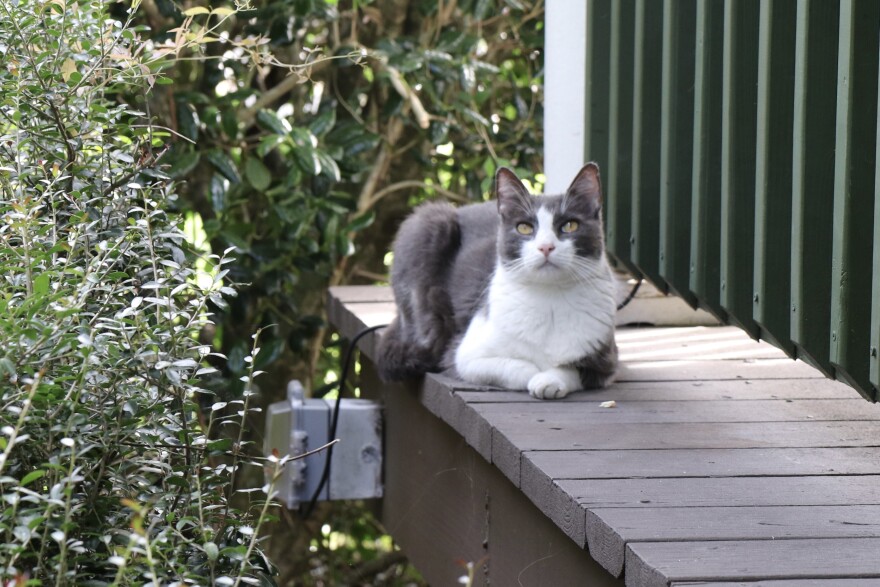Editor's note: An earlier version of this story stated that Leah Hawes from Operation Catnip cares for 7,060 cats when in fact she cares for 70 to 60 cats.
Free roaming cats, a common sight, beg for human affection while hunting native fauna for food and sport; this innate drive to kill has spurred concerns in environmental activists worldwide.
“They're very effective predators,” said Tonya Becker, a board member of the Alachua Audubon Society, which promotes bird conservation. “They will kill and eat, or just kill, for fun.”
Becker said one outdoor cat can kill a bird or a rodent a day, severely reducing wildlife populations. The Audubon Society prioritizes protecting and restoring wildlife with a mission to inspire appreciation for birds and other native species while advocating for sustainable resource use.
“One of the roles that those little rodents play is a food source for creatures that do belong here,” she said, “especially birds, owls [and] hawks.”
According to a 2017 study by Scott Ross and Peter Marra, at least 63 vertebrate extinctions are attributed to cat predation. The study confirms feral and domestic felines also contribute to the spread of disease to other wildlife and humans.

Erick Smith, full-time ecologist and co-owner of Kestrel Ecological Services, said cats are an invasive species, and he’s seen their predatory instincts in his own backyard.
“Feral cats are not native, and there’s a lot of wildlife that is not used to feral cats,” he said. “I think they should be trapped and, somehow, dealt [with] humanely.”
When invasive species are introduced to an ecosystem, they threaten native wildlife. Smith said he views the issue on a larger scale. When parts of the system are taken away, it becomes dysfunctional, making each little mouse, snake or lizard vital.
About 2,084 species encapsulate the outdoor cat diet globally, according to a 2023 study published in Nature Communications. Of these species, 498 are found in North America.
Ross and Marra’s 2013 study with Tom Will estimates cats kill between 1.3 to 4 billion birds and 6.3 to 22.3 billion small mammals annually.
However, a recent study has revealed the number of prey killed is far higher than previous estimates. Scientists are now pushing for better cat control and genetic testing, even without clear signs of predation.
Becker said several bluebird families have been breeding in her neighborhood for generations.

“There are virtually no bluebirds left in my neighborhood,’ she said, “And that's with just a few cats, maybe five.”
She is not the only person to notice fewer birds. Thomas Thurston, owner of the Green Market Nursery is also an avid bird lover.
“You know, it's a sore point because we used to have a lot of birds and they're gone because we can't get rid of the cats,” he said.
He said animal services took his concerns lightly, despite growing evidence from researchers about the ecological cost of outdoor cats. Nevertheless, other local residents see the situation differently.
“They don’t bother me,” said Danielle Armstrong, a resident at Clayton Estates.
The neighborhood has a large population of free-roaming felines. Armstrong said she is thankful the cats keep the rats and possums away. According to her, the homes, being so close together, are prone to infestations, especially in the summer. She added she has not seen any dead birds.
To control the feral cat population, many groups prefer to use the Trap-Neuter-Return (TNR) solution. The process is a humane approach focusing on trapping outdoor cats, sterilizing them, and then returning them to where they came from.
One of the largest nonprofit organizations actively implementing TNR in Gainesville is Operation Catnip. Leah Hawes, the development director of the organization, said she cares for 70 to 60 cats daily, emphasizing the team’s impact through the decrease in euthanization.
She said the project’s success relies on long-term consistency with a maintained focus on the cat’s well-being and future.
“When I think feral, I think of, ‘is this animal best suited for living outside,’ or ‘is it best suited for getting into an indoor home?’” she said. “Would it be happier and healthier in a different environment? Sometimes the answer is yes, sometimes the answer is no.”
Though Hawes has seen the impact of Operation Catnip’s efforts in controlling the feral cat population, Becker is hesitant to accept TNR as a definitive solution.
“The hypothesis was that they would die over time and not reproduce, and then you would gradually solve the problem,” she said. “The data doesn't bear that out.”
Smith is also skeptical.
“I think the trap-neuter part is awesome; it's just the release part that I have a problem with,” he said

TNR may reduce future births, but the returned feline will continue to hunt and potentially spread illnesses for the remainder of its lifespan. Cats rely on instincts, said Becker, and feeding them doesn’t curb this inclination. However, Hawes said spaying and neutering can lessen these tendencies.
Solutions can range in extremity from euthenasia to TNR and adoption. However, Smith has proposed a new method: a large, enclosed space for feral cats who remain unadoptable after rehabilitation and fixing.
Though in disagreement on TNR’s viability, Becker and Hawes agree the root cause of the issue is a lack of education, a primary means to effectively get cats out of the wild.
Education increases awareness on adoption and best practices, with Hawes noting that many are unaware of the available resources that can facilitate cat ownership. Additionally, Becker suggested adding the issue to the school curriculum, as a means of establishing the topic as common knowledge.
“We could do more education and get people enthusiastically to appreciate some of the nature around them and then to perhaps understand how they might be impacting it negatively with choices like letting their cats outside,” she said.
Regardless, the issue remains prevalent as Hawes said, there is no “quick-solution.”

